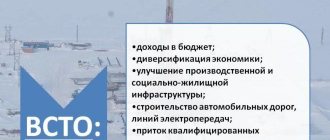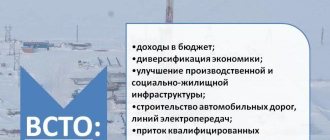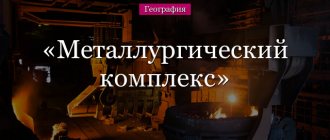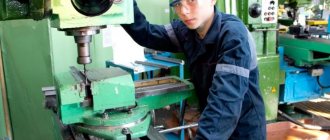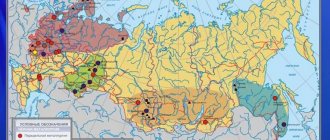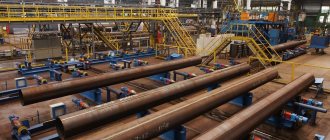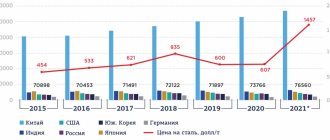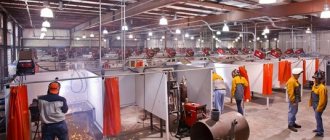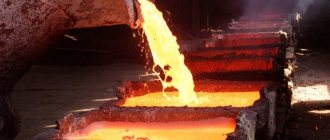The power and prosperity of the state depends on the efficiency of the economy and military potential. The development of the latter is impossible without the development of metallurgy, which in turn is the basis of mechanical engineering. Today the focus is on the metallurgical complex of Russia and its importance for the industrial and economic sphere of the country.
Factors of metallurgy location
The metallurgical complex includes ferrous and non-ferrous metallurgy .
Metallurgy in Russia, providing production and scientific and technical development of almost all industries, is based on domestic raw materials, focusing on foreign and Russian consumers. Russia accounts for 14% of commercial iron ore production and 10–15% of non-ferrous and rare metals mined in the world. In terms of production, consumption and foreign trade turnover, ferrous, non-ferrous and rare metals, as well as primary products from them, occupy second place after fuel and energy resources. Iron ores and primary products of ferrous metallurgy, aluminum, nickel, and copper remain important exports of the country. Large metallurgical enterprises are of regional importance. When they arise, a number of interconnected industries are formed - the electric power industry, the chemical industry, the production of building materials, metal-intensive engineering, various related industries and, of course, transport.
Ferrous metallurgy
Ferrous metallurgy serves as the basis for the development of mechanical engineering and metalworking, and its products are used in almost all spheres of the economy. It covers such stages of the technological process as mining, enrichment and agglomeration of ferrous metal ores, production of refractories, mining of non-metallic raw materials, coking of coal, production of cast iron, steel and rolled products, ferroalloys, secondary processing of ferrous metals, etc. But the basis of ferrous metallurgy is the production of cast iron , steel and rolled products.
Russia, along with the USA, Japan, China and Germany, is one of the top five global producers of ferrous metals. In 2004, Russia produced 105 million tons of iron ore, 51.5 million tons of cast iron, 72.4 million tons of steel and 59.6 million tons of finished rolled products.
The territorial organization of ferrous metallurgy is influenced by:
- concentration of production, in terms of which Russia occupies a leading position in the world - full-cycle metallurgical plants in Lipetsk, Cherepovets, Magnitogorsk, Nizhny Tagil, Novotroitsk, Chelyabinsk and Novokuznetsk produce more than 90% of cast iron and about 89% of Russian steel;
- production combination, meaning the unification at one enterprise of several interrelated industries of various industries;
- material intensity of production, providing 85–90% of all costs for smelting cast iron (the production of 1 ton of cast iron requires 1.5 tons of iron and 200 kg of manganese ore, 1.5 tons of coal, over 0.5 tons of fluxes and up to 30 m3 of recycled water) ;
- high energy intensity, which is higher than in developed countries of the world;
- high labor intensity at domestic metallurgical enterprises.
The production base of ferrous metallurgy consists of full-cycle enterprises: cast iron - steel - rolled products, as well as factories producing cast iron - steel, steel - rolled products and separately cast iron, steel, rolled products related to conversion metallurgy. Small metallurgy, or the production of steel and rolled products at machine-building plants, mainly from scrap metal, is distinguished.
The factors for locating ferrous metallurgy enterprises are extremely diverse. Full-cycle ferrous metallurgy is located either near sources of raw materials (Ural metallurgical base, metallurgical base of the central regions of the European part), or near fuel resources (West Siberian metallurgical base), or between sources of raw materials and fuel resources (Cherepovets Metallurgical Plant).
Pipe metallurgy enterprises, using mainly scrap metal as raw materials, focus on areas of developed mechanical engineering and places of consumption of finished products. Small metallurgy is even more closely connected with machine-building plants.
The production of electric steels and ferroalloys is distinguished by special placement factors. Electric steels are produced near sources of electricity and metal scrap (Elektrostal, Moscow region). Ferroalloys - alloys of iron with alloying metals - are produced in blast furnaces or by electrothermal methods at metallurgical enterprises and specialized plants (Chelyabinsk).
Main factors for locating ferrous metallurgy enterprises*
| Enterprises and production | Placement factors |
| Mining and processing plants | Raw materials |
| Coke and gas plants | As part of full-cycle metallurgical plants |
| Full cycle metallurgical plants | Raw materials, fuel, at sources of electricity and fresh water |
| Particle metallurgy | Gravitates towards mechanical engineering centers |
| Ferroalloy production | Gravitates towards large power sources and full-cycle metallurgical plants |
The natural basis of ferrous metallurgy are sources of metal raw materials and fuel. Russia is well supplied with raw materials for ferrous metallurgy, but iron ores and fuel are distributed unevenly throughout the country.
Russia ranks first in the world in iron ore reserves, of which more than half are concentrated in the European part of the country. The largest iron ore basin is the Kursk magnetic anomaly, located in the Central Black Earth region. The main reserves of KMA iron ores, recognized as the best in the world in terms of quality, are concentrated in the Lebedinskoye, Stoilenskoye, Chernyanskoye, Pogrometskoye, Yakovlevskoye, Gostishchevskoye and Mikhailovskoye deposits. The Kovdorskoye, Olenegorskoye and Kostomuksha fields are exploited on the Kola Peninsula and Karelia. Significant iron ore resources are in the Urals, where deposits (Kachkanarskaya, Tagilo-Kushvinskaya, Bakalskaya and Orsko-Khalilovskaya groups) stretch from north to south parallel to the Ural ridge. Iron ore deposits have been discovered in Western (Gornaya Shoria, Rudny Altai) and Eastern Siberia (Angaro-Pitsky, Angaro-Ilimsky basins). In the Far East, the Aldan iron ore province and the Olekmo-Amgunsky region in Yakutia are promising.
Manganese and chromium reserves in Russia are limited. Manganese deposits are being developed in the Kemerovo (Usinsk) and Sverdlovsk (Polunochnoye) regions, and chromium deposits are being developed in the Perm Territory (Sarany).
Metallurgical complex
Throughout the history of civilization, metals have been a universal subject of labor, the material basis of all tools and vehicles, as well as a structural material for buildings, structures and transmission devices. Unlike other types of material resources (for example, fuel, electricity, some chemicals), which are consumed one-time at the time of their use, metals, after appropriate processing, are converted into material elements of fixed assets and, in most cases, continue to be used as part of them.
Modern metallurgical production, the main divisions of which are ferrous and non-ferrous metallurgy
, is a complex industry, the most important features of which include the versatility and cyclical nature of technological processes, the presence of many processing stages, high resource and capital intensity and intensive impact on the environment. Metallurgical enterprises are large industrial complexes in which raw materials (primary and secondary) are processed through many stages using complex technology and equipment into a variety of metal products sold on the market. Modern metallurgical plants often also include mining, mineral processing and coke-chemical enterprises, as well as a whole range of related and auxiliary services. The annual capacity of the largest plants reaches 10 million tons or more of steel and 1 million tons of aluminum, and they employ tens of thousands of people.
Metallurgy in the structure of the modern economy occupies an intermediate position between the extractive industries of the primary sector, most of whose products are used for industrial consumption in other industries, and industries that sell their products in the sphere of final consumption. The products of the metallurgical complex are the main resource for the implementation of investment projects and play a vital role in the development of investment processes. At the same time, as a result of structural changes, metallurgy has turned into an industry whose economic interests are completely subordinated to the requirements of the consumption sectors, and therefore the economic situation in ferrous and non-ferrous metallurgy directly depends on the cyclical fluctuations in the dynamics of industries working for final demand.
19.1. Ferrous metallurgy
Ferrous metals (mainly steel and cast iron) occupy a special place in the overall structure of material costs due to the enormous scale and versatility of their use, as well as the complexity of further processing. Therefore, despite the expansion of production and use of plastics and non-ferrous metals, ferrous metals
remain
the main structural material
and, apparently, will retain their importance in the foreseeable future (Table 19.1).
In the first half of the twentieth century.
Steel production was determined by the growing needs of the economy and was accompanied by an extensive increase in production capacity and product output. It is estimated that over 4000 years of development of metallurgy, more than 11 billion tons of ferrous metals have been produced in the world. Of this amount, more than 80% occurred in the first 70 years of the twentieth century. For example, over the period 1900-2000, according to the International Iron and Steel Institute (IISI), world steel production increased from 28 million to almost 830 million tons. In the post-war period, metallurgy occupied a leading position in the process restoration and development of the world economy. Only for 1950-1970. world steel production increased more than three times with an average annual increase of about 5.9% (Table 18.2). In the USA this figure increased by 1.6 times, in Germany by 4 times, in Italy by 8.8 times, in France by 2.9 times, and in Japan by almost 25 times. Table 19.1. Balance of consumption of basic construction materials in the economies of leading countries, (% of total by weight)
| A country | Year | |||
| 1980 | 1995 | 2000 | 2015(forecast) | |
| Black metals | ||||
| USA | 91,1 | 88,3 | 85,3 | 82,7 |
| Japan | 93,6 | 90,4 | 89,8 | 88,1 |
| Germany | 94,5 | 88,1 | 85,9 | 84,0 |
| Aluminum | ||||
| USA | 2,5 | 4,9 | 5,6 | 6,1 |
| Japan | 0,9 | 3,1 | 3,5 | 3,8 |
| Germany | 1,8 | 4,6 | 4,4 | 4,7 |
| Copper, zinc, lead | ||||
| USA | 3,2 | 3,8 | 4,2 | 4,2 |
| Japan | 5 | 3,1 | 3,3 | 3,4 |
| Germany | 3 | 4,3 | 4,4 | 4,4 |
| Plastics competing with metals | ||||
| USA | 3,2 | 2,9 | 4,6 | 6,4 |
| Japan | 0,4 | 3,4 | 3,0 | 3,9 |
| Germany | 0,7 | 3,0 | 5,0 | 6,2 |
| New materials | ||||
| USA | 0,1 | 0,1 | 0,3 | 0,6 |
| Japan | — | 0,1 | 0,4 | 0,8 |
| Germany | — | 0,1 | 0,3 | 0,7 |
Source: Metals of Eurasia. 1997. No. 5.
Structural restructuring of the world economy in the last quarter of the twentieth century. fundamentally changed sectoral priorities of economic development. The growing role of new knowledge-intensive industries (computer science, biotechnology, electronics, aeronautics, nuclear energy, new branches of chemistry, etc.), the growing shortage and cost of energy and raw materials, the tightening of environmental standards - all this has significantly displaced the resource-intensive basic industries, until relatively recently determining the main dynamics of world development.
Resource conservation and, in particular, metal conservation have become one of the main principles of economic practice in all countries, which has affected the consumption of steel and the economic state of the ferrous metallurgy, for which the last quarter of the last century turned out to be, in a sense, a turning point. In the new, more stringent economic conditions, against the backdrop of the famous “energy shocks” of the 70s, the negative significance of such factors as rising production costs, a long capital turnover cycle, conservative multi-process technology, and a high level of environmental pollution has sharply increased. The volume of steel production, which until relatively recently was one of the main indicators of the state of the country's economy, has today lost its importance to a certain extent, although steel is undoubtedly the most important structural material and is in high demand on the market. Thanks to this, the world metallurgy, having survived a period of painful structural crises and overcoming the period of survival in the 80s, managed to maintain and strengthen its place in the updated structure of the economy.
The dynamics and nature of these processes in different countries were determined by the state of the economy and the rate of GDP growth.
Most economically developed countries were characterized by relatively low rates of increase in steel production and consumption due to the high metal saturation of the economy and its ongoing restructuring. In most developing countries, among which the so-called newly industrialized countries stand out - Korea, Taiwan, Mexico, Brazil, etc., on the contrary, the trends of dynamic growth in the production of ferrous metals continue. The main contribution to the global increase in steel production in the last decade was made by Asian countries (Japan, China, India, Korea, Taiwan), and the undisputed leader is China, where steel production in 2005 reached 345 million tons with an average annual growth for 1990-2005 gg. about 10% (Table 19.2). Table 19.2. Dynamics of world steel production in 1950-2005.
| A country | Year | |||||||||||
| 1950 | 1960 | 1970 | 1980 | 1990 | 2005 | |||||||
| million tons | % | million tons | % | million tons | % | million tons | % | million tons | % | million tons | % | |
| The world at large | 190 | 100,0 | 362 | 100,0 | 595 | 100,0 | 716 | 100,0 | 769 | 100,0 | 1 140 | 100,0 |
| including: | ||||||||||||
| The developed countries. | 148 | 78,0 | 225 | 62,0 | 382 | 64,0 | 384 | 54 | 361 | 47,0 | 402 | 35,3 |
| of them: | ||||||||||||
| USA | 88 | 46,0 | 90 | 25,0 | 119 | 20,0 | 101 | 14,0 | 90 | 12,0 | 92,7 | 9,6 |
| Japan | 5 | 2,6 | 22 | 6 | 93 | 16 | 111 | 16,0 | 110 | 14,0 | ||
| Germany | 12 | 6,4 | 34 | 9 | 45 | 8,0 | 44 | 6 | 38 | 5,0 | ||
| EU countries | — | — | 73,4 | 21,8 | 148 | 24,8 | 142 | 19,0 | 137 | 18 | 154 | 16,0 |
| Former CMEA member countries, | 36 | 19,0 | 104 | 29,0 | 157 | 26,0 | 210 | 29,0 | 207 | 27 | 145 | 12,7 |
| of which the former USSR | 27 | 14,0 | 65 | 18,0 | 116 | 19,0 | 148 | 21,0 | 154 | 20,0 | 111 | 11,1 |
| Developing countries, | 6 | 0,3 | 33 | 9 | 56 | 10 | 122 | 17 | 201 | 26 | 593 | 52 |
| of which China | 0,6 | 0,3 | 18,7 | 5,0 | 17,8 | 3,0 | 37 | 5,0 | 47 | 6 | 345 | 30,3 |
| Average annual growth rates by decade | 11,1 | 11,1 | 11,1 | 6,2 | 11,1 | 5,5 | 11,1 | 1,9 | 11,1 | 0,7 | 11,1 | 2,7 |
Source: Steel Market for relevant years.
The collapse of the USSR and the liquidation of the CMEA played a significant role in changing global proportions in the production of ferrous metals in the last decade. The roles of the main metallurgical powers also changed. In general, in modern ferrous metallurgy, several centers can be distinguished with their own characteristics of formation and development.
First of all, the US iron and steel industry
, which in the twentieth century, having created powerful potential in the pre- and post-war years, subsequently developed mainly through rather sluggish reconstruction and partial expansion of existing, and far from new, enterprises. This basically created the preconditions for a deep crisis in the early 80s, caused by an objective deterioration in the conditions for the reproduction of fixed capital (an increase in the cost of all elements of production costs), a lack of investment to update production capacities, a deterioration in resource supply and stricter environmental standards. In the US iron and steel industry, a huge, largely morally and physically outdated production apparatus has been formed, the effective use of which has become a complex economic and social problem. The presence of a huge mass of accumulated capacity in conditions of unstable market demand and unregulated growth of operating costs, rising costs for maintaining equipment with a slow increase in its economic returns, the flow of investment resources into knowledge-intensive industries and the service sector - all this sharply limited the investment opportunities of corporations and put the industry virtually at a standstill. the edge of survival.
Of the 35 plants with a full metallurgical cycle (having blast furnace, steelmaking and rolling stages), producing more than 75% of steel, 28 were built before 1910. The production efficiency at these enterprises (primarily labor productivity) was much lower than in Japan and EU countries. This significantly reduced the price competitiveness of American metal products. It is not surprising that, having significant metallurgical capacities, the American economy has satisfied at least a quarter of domestic demand through imports over the past 20 years. Adaptation of the industry to new conditions of reproduction was quite difficult and covered a wide range of issues of scientific, technical, organizational, managerial, socio-political nature, investment policy and state monopoly regulation.
In the 1980s, about 20 plants with a full metallurgical cycle were shut down, and the retirement rate of fixed capital in the industry exceeded 3% (in the previous decade - 1.5%). The US government, on the whole, did not hinder the development of joint business and contributed to the entry of foreign investment into the country in the metallurgy industry. As a result, during this period foreign investments (mainly Japanese, Korean, Brazilian) in the industry amounted to about 25% of total capital investments. By the beginning of this century, about a quarter of all US iron and steel plants were controlled to one degree or another by foreign capital. At the same time, deliberately losing ground in traditional resource-intensive industries (metallurgy, shipbuilding, forestry, mining), the US government supports and protects corporations in knowledge-intensive industries that determine the country's technical superiority.
Japanese iron and steel industry
was one of the most important factors in the post-war Japanese “economic miracle”. A backward agricultural country that lost the war, was practically deprived of a raw material base, and embarked on the path of industrialization very late, literally in 10-15 years it covered a path that other countries with developed metallurgy spent at least half a century on. Taking advantage of the favorable conditions of the post-war economic recovery, relatively cheap imported raw materials in the 50-60s, and government support, Japan chose the progressive path of creating a ferrous metallurgy through the construction of large factories with a full cycle on specially reclaimed land areas in the coastal strip. This actually turned such a plant into a port for receiving large sea vessels supplying raw materials and fuel from Australia, India, China and other countries.
Ferrous metals became one of the important export goods in the 50-60s, and Japan became the world's leading exporter. The most important factor in the competitiveness of Japanese iron and steel industry on the world market was, firstly, the effective use of foreign scientific and technical innovations, which significantly reduced production costs and the gap with leading countries, and, secondly, the creation of its own powerful R&D sector in the largest corporations and universities . Thanks to this, by the beginning of the 80s, Japan was far ahead of all countries in terms of technical level, and the share of value-added products in metallurgical production significantly increased, which further strengthened the positions of companies in the world market.
Since the mid-80s, leading Japanese companies, in accordance with the concept of economic development, began to gradually transfer abroad (mainly to the countries of Southeast Asia) those metallurgical processes that are engaged in the production of mass, relatively cheap products, the unique “lower floors” of the industry. This should contribute to the gradual restructuring of metallurgy into a more compact, resource-saving, environmentally friendly and technically advanced industry, corresponding to a fundamentally new model of development of the Japanese economy and the concept of the country’s participation in the international division of labor in the new century.
Ferrous metallurgy of Western Europe
is represented by the largest state-integration association within the European Union, which grew out of the European Coal and Steel Community (ECSC) created in the early 50s, which accounts for up to 85% of European and about 17% of world steel production. Using the achievements of scientific and technological progress and the rich technical traditions of European metallurgy in the context of the post-war economic recovery, as well as the advantages of integration and government support, EU companies were able to create modern production in a relatively short time, significantly surpassing the scale of the United States and Japan.
The main goal of the ECSC was to promote economic development and employment growth in member countries by creating a common product market. At the same time, the following tasks were set: ensuring rational placement and sustainable growth of production, increasing its efficiency, eliminating economic shocks, promoting the modernization of production capacities, equal access to resources and equal rights in trade, and exercising price control. The main principle of the association’s activities is to ensure conditions for free and normal competition. The primary goals of this regulation are to prevent an increase in production volumes that could upset the balance in the metal market within the EU, and to stimulate the growth of competitiveness of EU countries' metal products on the world market through structural restructuring of the industry. An important motivating factor for this was the crisis that engulfed the iron and steel industry in Western Europe in the early 1980s, the impact of which was particularly acute for state-owned companies, most of which were nationalized after the war. Therefore, the determining factor in the restructuring was the wave of the so-called reprivatization of the metallurgical business.
The main mechanisms ensuring the conditions for normal competition include: regulation of prices for metal products; control over the processes of international and national interweaving of capital; restriction of preferential lending and subsidies; limiting excessive levels of monopolization. The latter circumstance is carried out through strict control over mergers and acquisitions of companies. However, in the late 1980s, the EU Council of Ministers significantly weakened these restrictions due to the growing concentration of production among the main competitors of the United States and Japan.
An example of comprehensive regulation of the EU ferrous metallurgy in 1979-1989. are targeted anti-crisis programs that included reducing the “excess” capacity of the metallurgy of the member countries of the Community, regulating pricing, quotas for the production of specific types of products, and regulating subsidies. So, for 1983-1989. About 27 million tons of steel smelting capacity were liquidated.
In general, the regulation of the EU iron and steel industry represents a successful example of interaction between private business, the state and supranational non-governmental bodies represented by the ECSC and the EU Commission
. Practice has shown that individually, none of these structures can fully coordinate the development of ferrous metallurgy. At the same time, government intervention is mainly indirect in nature, it concerns tax, depreciation, credit policies, ecology, standardization, foreign economic protective measures and government procurement of products.
Chinese iron and steel industry
in the last decade has demonstrated growth rates unprecedented in history and has become one of the main factors in the development of global metallurgical production. Over the past decade, steel production in China has increased 5 times and reached 345 million tons in 2005. Large-scale industrialization of the country under state control, supported by a powerful flow of foreign investment (about 80 billion dollars per year) and export revenues (30 billion dollars per year), ensured exceptionally high dynamics of economic growth. In recent years, more than 65% of investments have gone into capital construction and technical re-equipment of enterprises in all sectors of the economy - from mining and metallurgical enterprises to the production of weapons and durable goods, science, and space, which stimulates the growing demand for construction materials. The country's domestic consumption of ferrous metals is growing very dynamically, which in 2005 reached about 400 million tons (steel equivalent). A significant part of metal products is used by the rapidly growing (annual growth of about 25%) automotive industry.
The potential of the industry is 150 plants, with the most dynamically developing medium and small enterprises with an annual capacity of 0.5 to 3 million tons, the share of larger plants in total steel production is slightly more than 40%. The basis for growth is the active investment policy of the government: in 2001-2005. More than $18 billion will be invested in ferrous metallurgy.
However, such rapid unbalanced growth of one of the basic industries can lead to serious distortions in the structure of the economy. The State Development and Reform Commission has repeatedly issued official warnings to the metallurgical sector about the need for a balanced approach to capacity expansion, which could exceed the consumer capacity of the market and exacerbate environmental problems. As a result, China has stepped up protectionist measures to protect its market by imposing higher duties and quotas on imported steel products.
According to forecasts of leading foreign experts, the “steel boom” in China may last several more years until a certain level of metal saturation of the country’s economy is reached, then we can expect serious changes in the structure of the industry, which can cause serious consequences not only in the economic, but also in the social sphere.
Answer
Metallurgical complex: composition, main metallurgical bases and factors for locating enterprises. Problems and prospects for development. Metallurgy and environmental problems. The quantity and quality of smelted metal largely determines the economic power of the state.
The industry includes ferrous (mining iron ore, smelting steel, cast iron and ferroalloys) and non-ferrous metallurgy (production of light (aluminium, magnesium, titanium) and heavy (copper, nickel, tin, lead) metals).
Metallurgy heavily pollutes air and water, and the environmental factor becomes the main factor for its location.
To produce 1 ton of steel, 7 tons of ore and coke are needed, so the location of the industry is also influenced by raw materials and fuel factors. New production does not require coke, but requires a lot of electricity, i.e. the energy factor is also important for the industry.
The main bases of non-ferrous metallurgy are Central (around KMA), Ural and Siberian (in the south of Western Siberia).
Ores of heavy non-ferrous metals are characterized by a low metal content in the ore (to smelt 1 ton of copper, 100 tons of ore are needed, 1 ton of tin requires 300 tons), i.e., the main factor of placement is the raw material. Light non-ferrous metals are produced by electrolysis. Therefore, their production is very energy-intensive (to produce 1 ton of aluminum requires 17 thousand kW • h of electricity, and 1 ton of titanium requires up to 60 thousand kW • h). Consequently, the main factor in the location of this production is energy.
Factors of location of non-ferrous metallurgy in Russia
The location of non-ferrous metallurgy gravitates towards sources of raw materials, fuel and energy. Due to the low metal content in ores, their primary processing (i.e. enrichment) is strictly tied to the areas of raw material extraction. But the next stages of metallurgical processing are mainly focused on fuel bases (production of nickel and zinc) or cheap electricity (production of aluminum, magnesium, titanium). This, however, is only a “general scheme” of placement, and life, as we know, is much richer than any schemes.
Raw materials, fuel and energy have different effects on the location of different enterprises in the industry. Thus, the smelting of blister copper (which still contains impurities) occurs in raw material areas and areas rich in fuel. The final stage - copper refining (i.e. its purification) - can also be located in areas of consumption.
In the aluminum industry, at the first stage, a concentrate is produced from aluminum ores (bauxite or nepheline). It is called alumina and is pure aluminum oxide. At the second stage of production, aluminum is reduced from oxide at high temperatures in electric furnaces.
The production of alumina, being material-intensive, gravitates towards places where aluminum ores are mined, and the extremely energy-intensive smelting of aluminum metal gravitates towards cheap electricity.
If to produce 1 ton of steel at an electrometallurgical plant it is necessary to spend 9,000 kWh of electricity, then to smelt 1 ton of aluminum - already 18,000, and 1 ton of titanium - even 50,000 kWh!
General characteristics of the metallurgical complex
What are mining and metallurgical complexes? This is a set of enterprises that are engaged in mining, beneficiation, metal smelting, rolled metal production and processing of secondary raw materials. The following industries are part of the metallurgical complex:
- Ferrous metallurgy , which deals with the smelting of steel, cast iron and ferroalloys;
- Non-ferrous metallurgy , which produces light (titanium, magnesium, aluminum) and heavy metals (lead, copper, tin, nickel).
Rice. 1 Metallurgical plant
Principles of business location
Enterprises of the mining and metallurgical complex are not located randomly. They depend on the following factors of metallurgy location:
- Raw materials (physical and chemical characteristics of ores);
- Fuel (what type of energy must be used to produce metal);
- Consumer (geography of placement of raw materials, main energy sources and availability of transport routes).
Rice. 2 Fuel factor of metallurgy location
Non-ferrous metallurgy
Based on their purpose and chemical and physical characteristics and properties, non-ferrous metals are divided into:
- Heavy (copper, lead, tin, zinc, nickel);
- Lightweight (aluminum, titanium, magnesium);
- Precious (gold, silver, platinum);
- Rare (zirconium, indium, tungsten, molybdenum, etc.)
Non-ferrous metallurgy is a complex of enterprises that is engaged in the extraction, enrichment and metallurgical processing of non-ferrous, precious and rare metal ores.
In this chain, aluminum, copper, lead-zinc, tungsten-molybdenum and titanium-magnesium industries are distinguished. In addition, this also includes enterprises producing precious and rare metals.
Features of non-ferrous metallurgy in Russia
They say that if ferrous metallurgy provides the industry with “bread”, then non-ferrous metallurgy provides it with “butter”. The total smelting of all non-ferrous metals (about 70 of them are produced in the country; Fig. 60) is tens of times less than the smelting of steel. But the use of non-ferrous metals in the economy improves the structure of the economy and makes it more progressive. Without non-ferrous metals, it is impossible to produce high-quality steel and semiconductors. They are needed for the production of space technology, catalysts for the chemical industry, automobile filters for purifying exhaust gases, coatings for high-capacity magnetic memory disks and other types of products in the field of latest technologies.
Russia's role is especially large in the global production of aluminum, nickel, copper, titanium, tin and gold.
Non-ferrous metal ores are characterized by low metal content
. Compare: average quality iron ore contains 30-40% iron (rich - 60-70%), and copper ore is considered very rich if it contains about 5% copper. Molybdenum ore contains only a few hundredths of a percent of molybdenum!
Another feature of non-ferrous metal ores is their multicomponent composition
, i.e. they contain several different metals. For example, the Ural so-called “copper” ore also contains nickel, zinc, chromium, other metals and non-metals - sulfur. In this regard, the production of zinc and copper is accompanied by the release of waste - sulfur dioxide. It can be the basis for the production of sulfuric acid. Due to the complex composition of ores, non-ferrous metallurgy “attracts” other industries.
Non-ferrous metallurgy centers in Russia
The centers of the aluminum industry are Bratsk, Krasnoyarsk, Sayansk and Novokuznetsk. Large aluminum smelters located in these cities are developed on the basis of their own raw materials from the Urals, the North-Western region and Siberia, as well as imported ones. This production is quite energy-intensive, so the enterprises are located near hydroelectric and thermal power plants.
The main center of the copper industry of our country is the Urals. Enterprises use local raw materials from the Gaisky, Krasnouralsky, Revdinsky and Sibaysky deposits.
The country's lead-zinc industry depends on the extraction of polymetallic ores, which is why it is located close to their mining sites - Primorye, the North Caucasus, Kuzbass and Transbaikalia.
Rice. 3 Gold mining in Chukotka
Location of non-ferrous metallurgy industries in Russia
The copper industry originated in Russia in the Urals. Over almost 300 years of heavy exploitation, many ore deposits here have been depleted. Nowadays, Ural copper smelters use both local and imported (mainly Kazakh) raw materials.
The largest center of copper-nickel production, Norilsk (Fig. 61), was created in Eastern Siberia in the 1930s. The plant in this polar city produces about half of Russian copper, 1/3 of nickel, almost all of platinum, as well as gold, cobalt and other metals. The activities of this giant of non-ferrous metallurgy, alas, are far from useful for the residents of the city and the surrounding nature. The plant is the largest air polluter in Russia, primarily with sulfur dioxide.
Prospects for the development of the copper industry in Eastern Siberia are associated with a unique deposit of copper ore in the Udokan Range in the north of the Chita region. In terms of ore reserves, it is one of the largest in the world, and the copper content in this ore is high - 1.5%! This deposit is only just beginning to be developed.
End >>>
Problems and prospects
There are problems in every industry. The metallurgical complex is no exception. Among the main problems of ferrous and non-ferrous metallurgy, the following can be identified:
- high energy consumption;
- low capacity of the domestic market;
- high level of depreciation of fixed production assets;
- shortage of certain types of raw materials;
- destruction of the process of reproduction of raw materials and ore reserves;
- technological backwardness and insufficient introduction of new technologies;
- shortage of professional personnel.
But all these issues can be resolved. Russia continues to be a major player in the global metallurgical products market. The share of Russian metallurgy in world production accounts for more than 5% of steel, 11% of aluminum, 21% of nickel, and more than 27% of titanium. The main indicator of the competitiveness of Russian metallurgy on the foreign market is that the country maintains and even expands its export capabilities.
